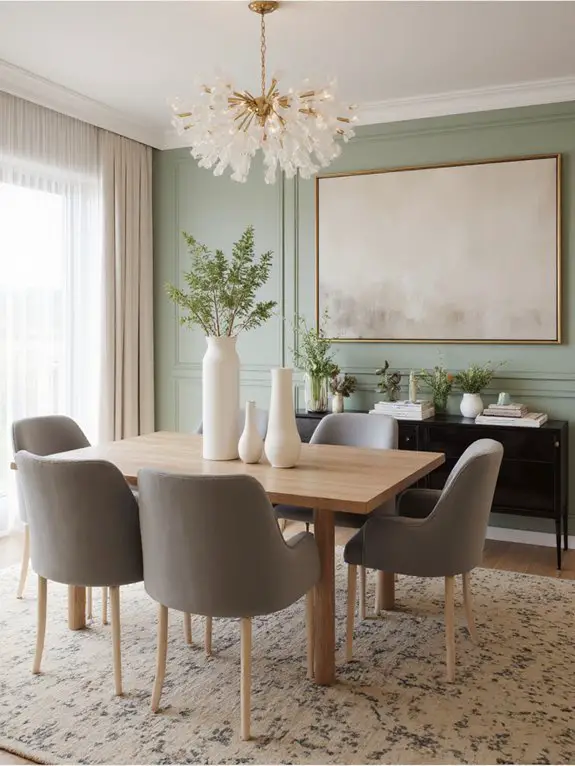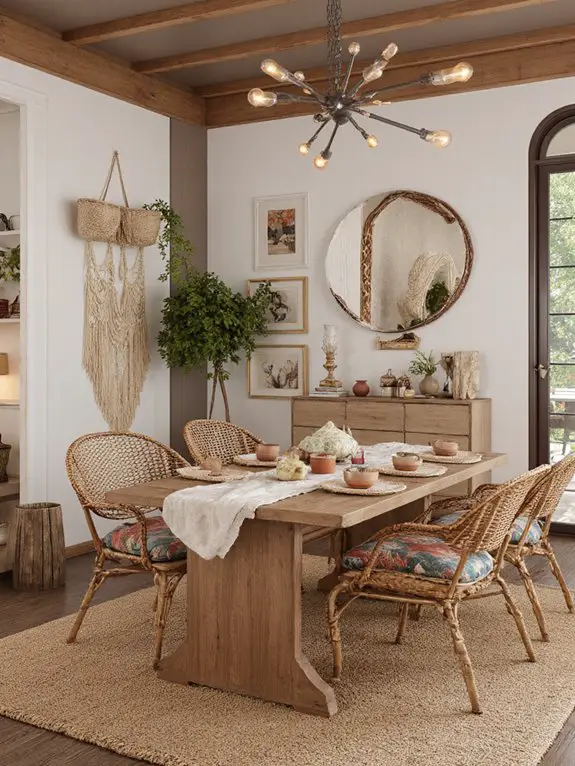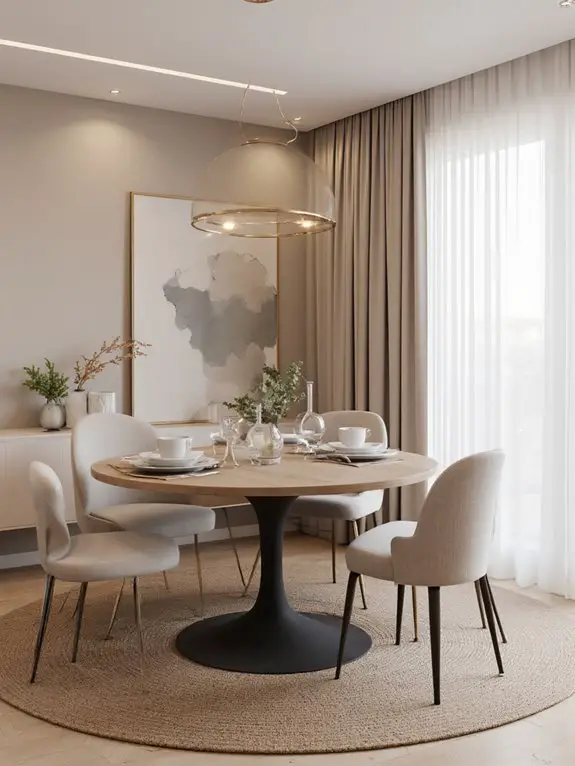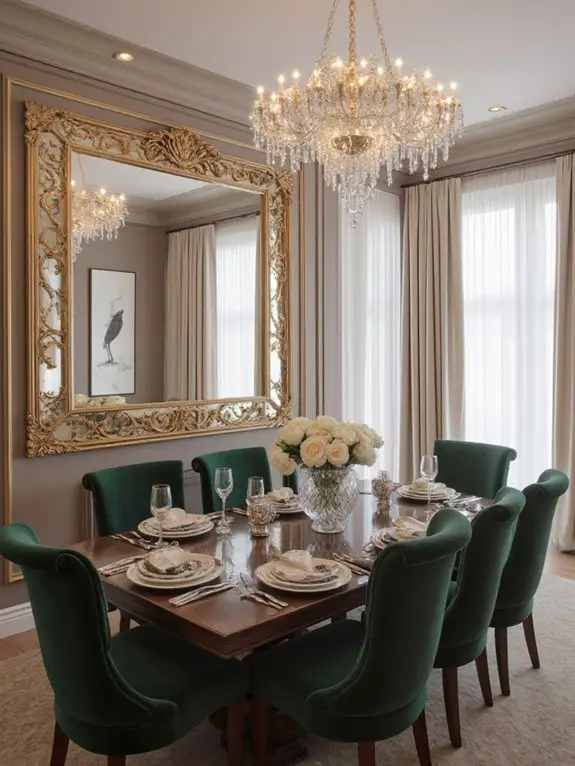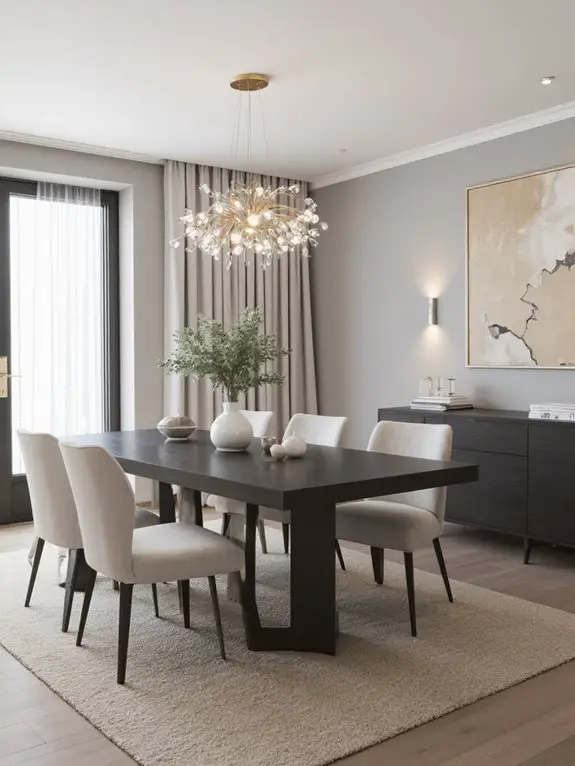I’ll help you transform your dining room with 25 unique decor ideas that blend style and function. Mix wooden and wicker chairs for cohesion, or pair modern with vintage for contrast. Use statement lighting like bold chandeliers or industrial pendants as a focal point. Add texture with gallery walls, patterned curtains, or sculptural centerpieces. Open shelving and multi-functional furniture maximize space and practicality. Discover how these tips can elevate your dining space into a stylish yet functional haven.
Mix and Match Dining Chairs for Eclectic Charm
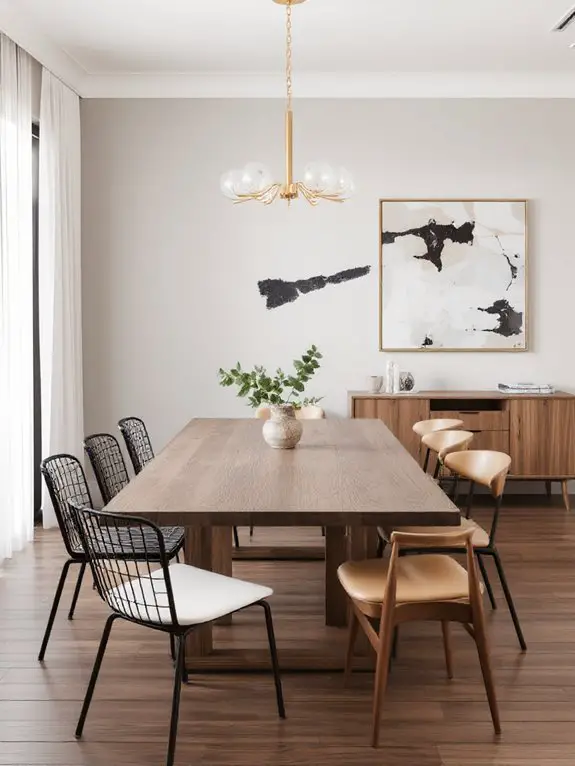
When I first considered mixing and matching dining chairs, I wondered if it would look chaotic rather than charming. But I discovered that intentional variety adds personality and depth to a dining space.
I started by choosing a unifying element, like color or material, to guarantee cohesion. For example, I paired wooden chairs with wicker ones, using a shared natural tone.
Different styles, like a modern chair with a vintage one, can create contrast while staying visually balanced.
I also recommend keeping the chairs’ heights similar for practicality. Mixing chairs lets me express creativity while maintaining a cohesive dining environment.
Statement Lighting Fixtures as a Focal Point
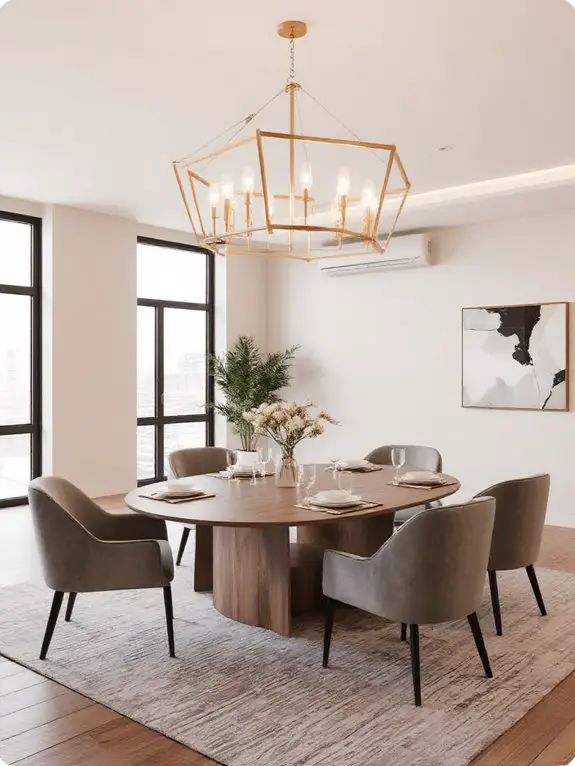
Just as mixing chairs can add character to a dining room, a statement lighting fixture can transform the entire space by drawing the eye and setting the mood. I always recommend choosing a fixture that complements the room’s scale and style—whether it’s a sleek modern chandelier, an industrial pendant, or a rustic lantern.
Position it centrally over the table to anchor the space and confirm it’s hung at the right height, typically 30 to 36 inches above the table. Opt for dimmable lights to control ambiance during meals.
A bold fixture not only illuminates but also becomes a conversation piece, elevating the room’s design.
Bold Wallpaper for Dramatic Impact
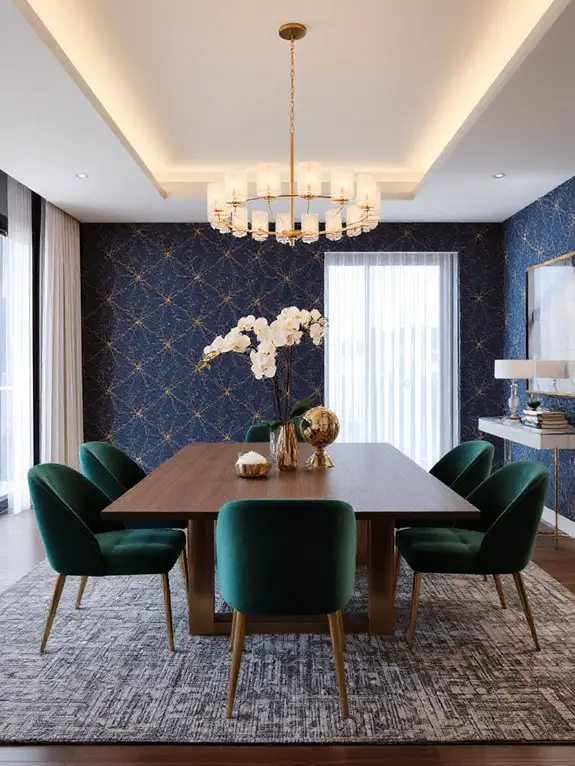
While many focus on furniture or lighting, bold wallpaper can instantly redefine a dining room’s atmosphere with a dramatic and personalized touch. I’ve found that choosing a striking pattern or vibrant color can transform a plain space into a conversation starter.
Opt for large-scale botanical prints or geometric designs to create depth, or go with metallic accents for a touch of luxury.
To avoid overwhelming the room, pair bold wallpaper with neutral furniture and minimalist decor. I recommend testing samples in different lighting conditions to guarantee the design complements your dining area’s overall aesthetic and mood.
Open Shelving for Display and Functionality
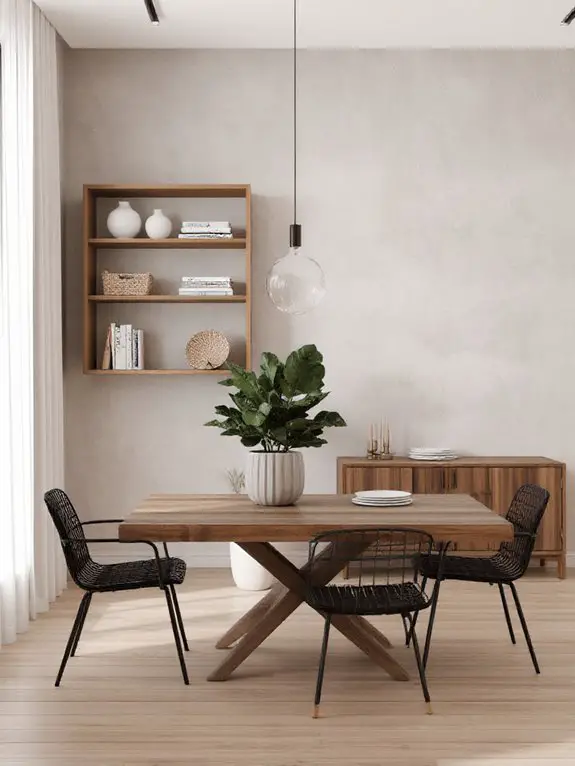
Bold wallpaper can transform a dining room’s look, but open shelving offers a versatile alternative that combines style and practicality. I love how it allows me to display dishes, glassware, or decorative pieces while keeping them easily accessible.
To avoid clutter, I stick to a cohesive theme, like matching ceramics or neutral tones. Floating shelves add a modern touch, while rustic wooden ones create warmth. I use them to highlight standout items, leaving some negative space to keep the design balanced.
Open shelving also encourages organization—it’s a great way to keep essentials within reach while adding personality to the room.
Natural Elements for a Rustic Touch
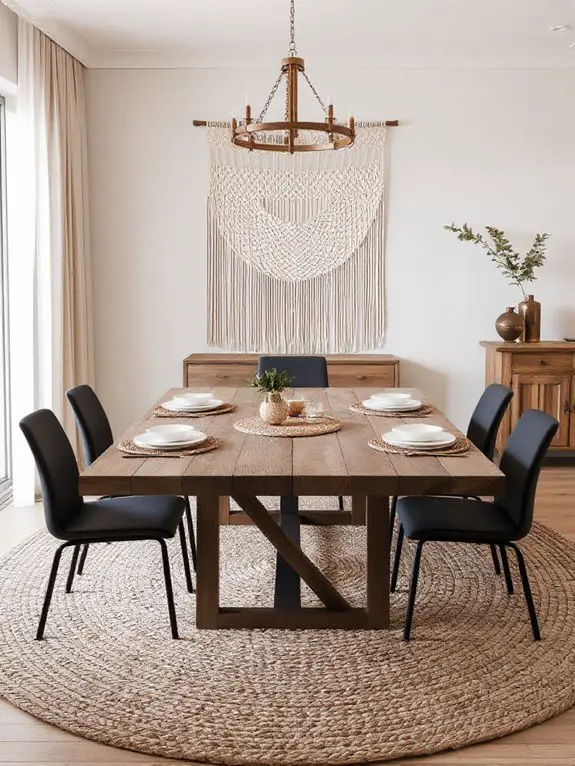
Although modern design has its appeal, I’ve found that incorporating natural elements into a dining room can create a rustic charm that feels timeless and inviting. Start with a wooden dining table—reclaimed oak or walnut adds warmth and texture. Pair it with woven rattan chairs or a jute rug to soften the space.
Stone accents, like a slate centerpiece or marble coasters, bring earthy elegance. Fresh greenery or dried branches in a ceramic vase add life without overwhelming.
These touches balance ruggedness with refinement, making the room feel cozy yet polished. Natural materials age beautifully, ensuring your decor stays relevant.
Monochromatic Color Schemes for Elegance
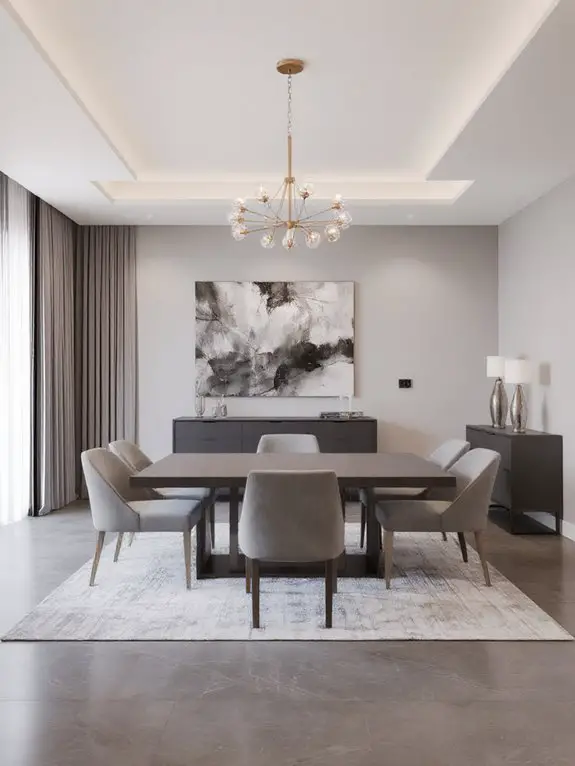
To achieve a sleek and cohesive look in your dining room, consider a monochromatic color scheme—it’s a simple yet impactful way to create elegance.
I’ve found that sticking to one color family, whether it’s shades of gray, blue, or beige, makes the space feel polished and intentional. Start with a base tone for walls, then layer in lighter and darker hues through furniture, textiles, and decor.
This approach avoids visual clutter while adding depth. I recommend incorporating varying textures, like a plush rug or metallic accents, to keep it dynamic. It’s effortless sophistication that never goes out of style.
Vintage Mirrors to Enhance Space
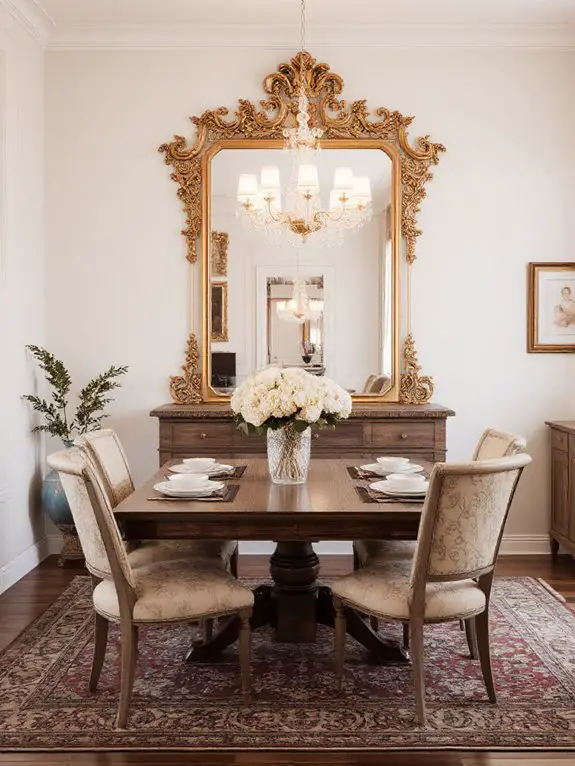
Vintage mirrors offer a timeless way to expand the visual depth of your dining room while adding character. I love placing an ornate, antique mirror above a sideboard or buffet—it reflects light and creates the illusion of a larger space.
Choose mirrors with intricate frames in gold, silver, or distressed finishes to complement your decor. A large, statement mirror can serve as a focal point, while smaller, grouped mirrors add a curated, eclectic vibe.
Positioning them strategically to catch natural light brightens the room. Vintage mirrors not only elevate the aesthetic but also infuse charm and history into your dining space effortlessly.
Layered Rugs for Texture and Warmth
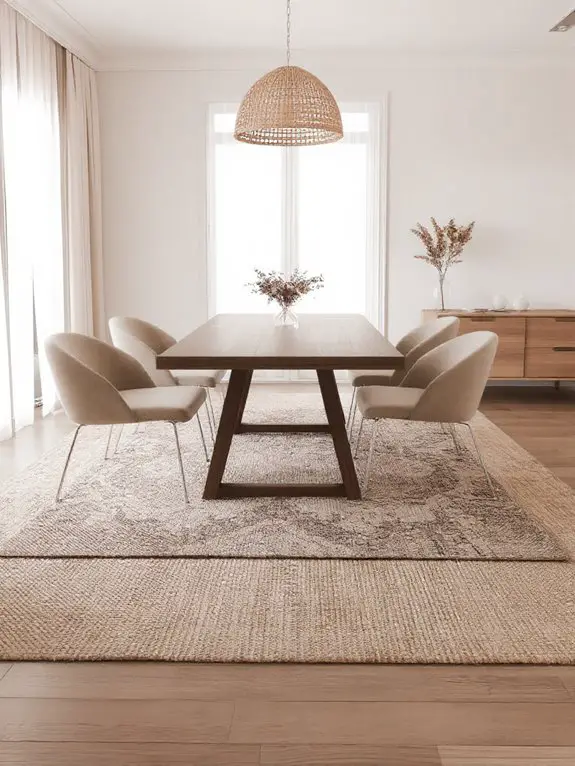
When I think about adding depth and coziness to a dining room, layering rugs is one of my go-to techniques. Start with a larger, neutral rug as the base to anchor the space, then add a smaller, patterned or textured rug on top for visual interest.
I prefer mixing materials like jute or sisal with wool or shag to create contrast. Confirm the rugs complement the room’s color scheme and furniture.
This approach not only enhances warmth underfoot but also softens the acoustics and ties the seating area together. Layered rugs are practical, stylish, and instantly transform the dining experience.
Floating Shelves for Minimalist Appeal
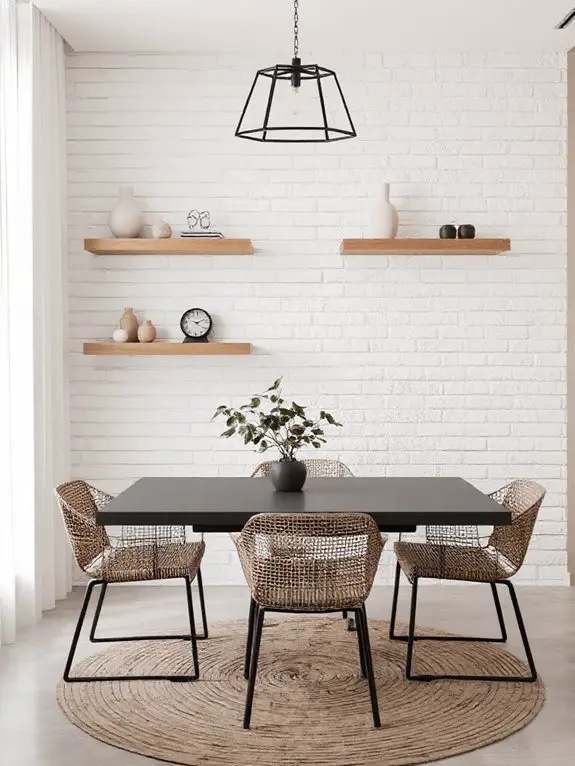
If I’m aiming for a clean, uncluttered look in the dining room, floating shelves are a must. They keep surfaces free while adding storage and style. I’d choose shelves in neutral colors or natural wood tones to maintain simplicity.
For a cohesive feel, I’d arrange a few curated items—like a small plant, a sculptural bowl, or a stack of books—sparingly to avoid clutter. Installing them at varying heights creates visual interest without overwhelming the space.
Floating shelves also make the walls feel purposeful while letting the room breathe. They’re perfect for showcasing essentials while keeping the focus on the overall design.
Gallery Wall to Showcase Art
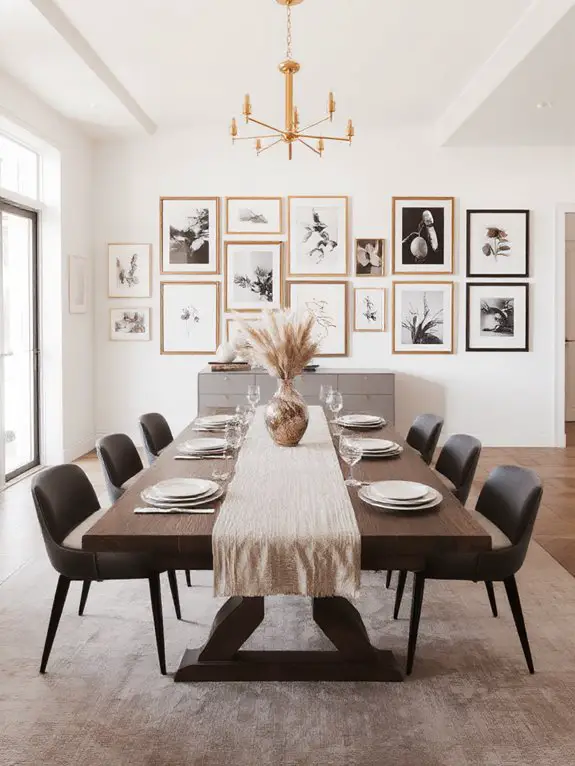
Since I want to infuse personality into my dining room without overwhelming the space, I’m considering a gallery wall to showcase art. A thoughtfully curated collection of framed pieces adds depth and character, transforming a plain wall into a focal point.
I’ll start by selecting artwork that complements the room’s color palette and style, mixing photographs, paintings, or prints for variety. To maintain balance, I’ll arrange frames in a cohesive layout, like a grid or asymmetrical design, ensuring spacing is consistent.
Including pieces of different sizes adds visual interest, while a unifying frame color ties everything together seamlessly.
Industrial-Inspired Furniture for Edge

To add an edge to my dining room, I’m leaning toward incorporating industrial-inspired furniture, which combines functionality with raw, bold aesthetics. I’m drawn to pieces like metal-framed tables with reclaimed wood tops, which bring texture and character.
Exposed hardware, such as rivets or bolts, adds an authentic industrial vibe. I’m also considering chairs with sleek, welded steel frames and leather or canvas seats for a rugged yet refined look.
Lighting plays a role too—pendant lights with Edison bulbs or black metal fixtures enhance the theme. This style creates a striking, modern space while maintaining practicality and durability for everyday use.
Bench Seating for Casual Comfort
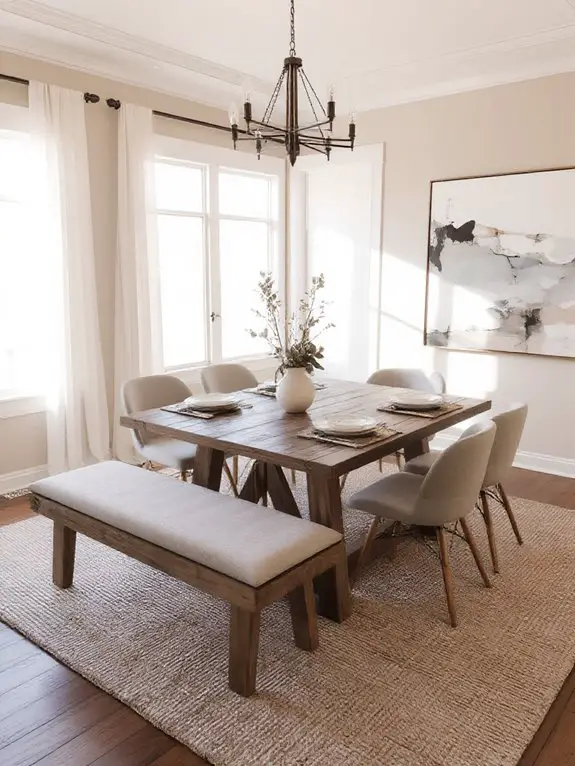
While I enjoy the boldness of industrial-inspired furniture, I’ve found that incorporating bench seating can soften the look and add a sense of casual comfort to my dining room. A bench along one side of the table creates an inviting, laid-back vibe, perfect for family gatherings or informal meals.
I prefer upholstered benches for added cushioning, but wooden ones also work well for durability and texture. Mixing benches with chairs adds visual interest and saves space. To personalize, I add throw pillows or a cozy blanket, making the area feel warm and functional.
Bench seating effortlessly balances style and practicality.
Metallic Accents for Glamorous Flair
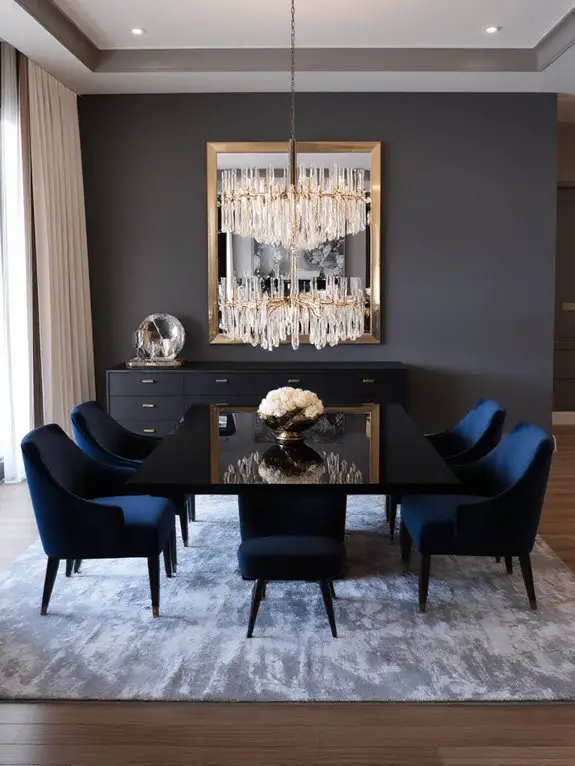
Metallic accents can instantly elevate a dining room, bringing a touch of glamour and sophistication to the space. I love incorporating elements like brushed gold light fixtures, mirrored centerpieces, or chrome chair legs to create a polished look. Even small details, such as metallic napkin rings or a silver pitcher, can make a big impact.
Mixing metals adds depth; try pairing warm tones like brass with cooler ones like stainless steel for visual interest. Opt for high-quality finishes to avoid a cheap appearance.
Metallic pieces reflect light, making the room feel brighter and more inviting. Balance them with softer textures to avoid overwhelming the space.
Oversized Plants for Freshness
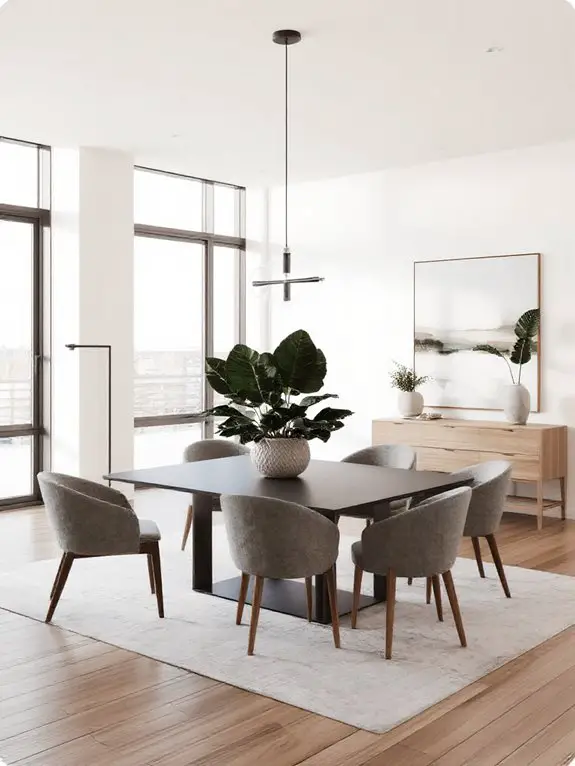
After adding a touch of glamour with metallic accents, I often balance the look by introducing oversized plants to bring freshness and life to the dining room. Large fiddle leaf figs, monsteras, or bird of paradise plants work wonderfully as statement pieces, creating a vibrant atmosphere.
I place them in bold, textured pots that complement the room’s palette. These plants not only purify the air but also soften the space, making it feel more inviting. I make sure they’re positioned near natural light and rotate them occasionally for even growth. It’s a simple yet impactful way to infuse nature into your decor.
Patterned Curtains for Visual Interest
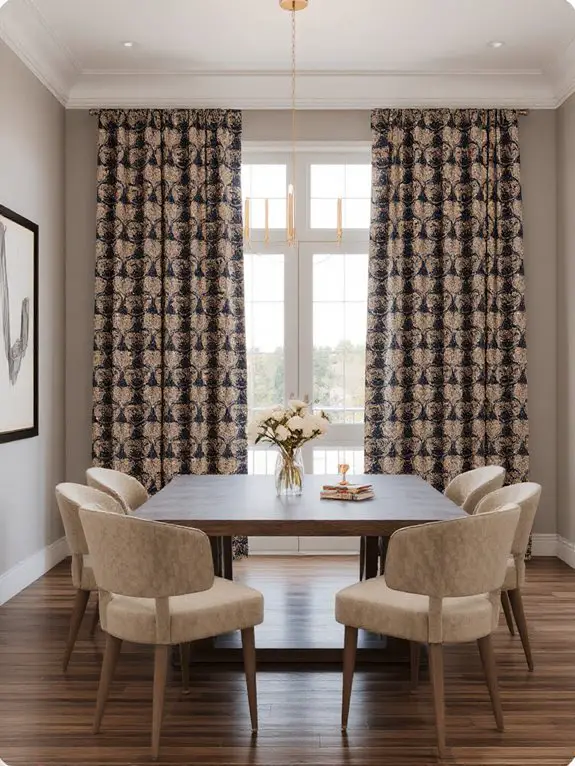
To elevate the dining room’s aesthetic, I often turn to patterned curtains as a way to introduce texture and visual depth. Bold geometric designs or subtle floral prints can anchor the space, while color coordination ties the room together.
I recommend choosing patterns that complement existing furniture or decor without overwhelming the eye. Lightweight fabrics like linen add airiness, while heavier materials like velvet provide a cozy, formal feel.
For smaller rooms, I opt for vertical stripes to create height, while larger spaces benefit from intricate motifs. Layering sheer panels behind patterned curtains adds versatility, allowing light control while maintaining style.
Chalkboard Wall for Creative Menus
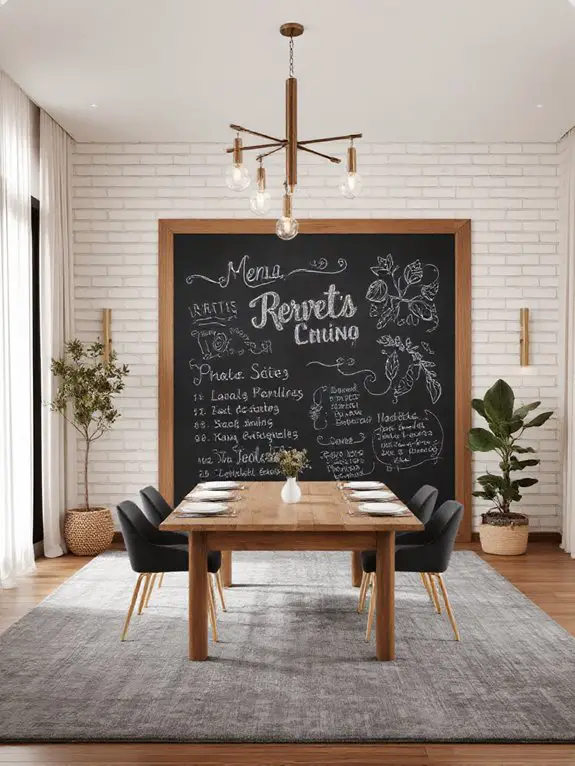
Though often overlooked, a chalkboard wall can transform your dining room into a dynamic and personalized space. I’ve found it’s perfect for showcasing creative menus, daily specials, or even inspirational quotes. It’s not just functional—it’s an artistic feature that invites interaction.
I recommend choosing a high-quality chalkboard paint for durability and ease of cleaning. Use chalk markers for crisp lines and vibrant designs. Incorporate frames or borders to blend it seamlessly with your decor.
It’s a versatile addition that lets you update the look whenever inspiration strikes, making your dining area feel fresh and engaging.
Glass Top Tables for Modern Simplicity
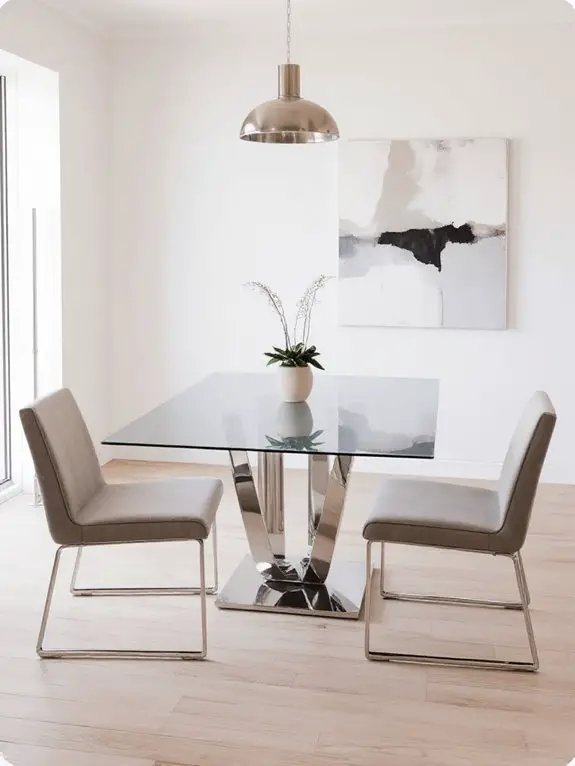
Glass top tables bring a sleek, contemporary vibe to any dining room, especially when aiming for a modern aesthetic. I love how they create an illusion of space, making smaller rooms feel more open and airy. Their reflective surface adds light, enhancing the overall brightness of the area.
Available in various shapes—round, rectangular, or oval—they pair effortlessly with minimalist or industrial decor. I recommend choosing a sturdy base in materials like metal or wood to balance the transparency of the glass.
Cleaning is straightforward with just a microfiber cloth, ensuring they stay pristine. Glass top tables are timeless, functional, and effortlessly elevate any dining space.
Mismatched Dinnerware for Playful Style
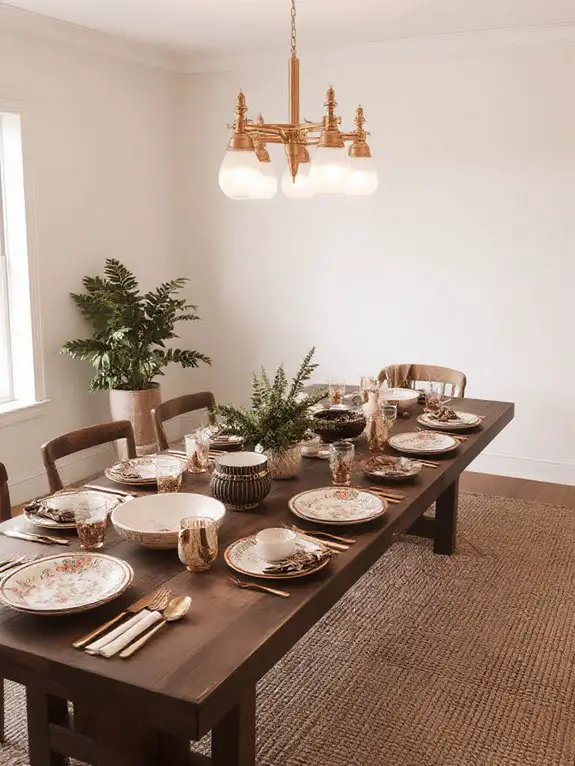
If you’re looking to inject personality into your dining room, mismatched dinnerware offers a fun and creative way to break free from traditional uniformity. I love mixing patterns, colors, and textures to create a lively, eclectic table setting.
Start by choosing a unifying theme, like a specific color palette or era, to tie everything together. Thrift stores and flea markets are great for finding unique pieces that add character.
Don’t be afraid to combine modern plates with vintage bowls or bold prints with subtle designs. This approach not only makes your dining experience more dynamic but also sparks conversation among guests.
Built-In Banquettes for Cozy Seating
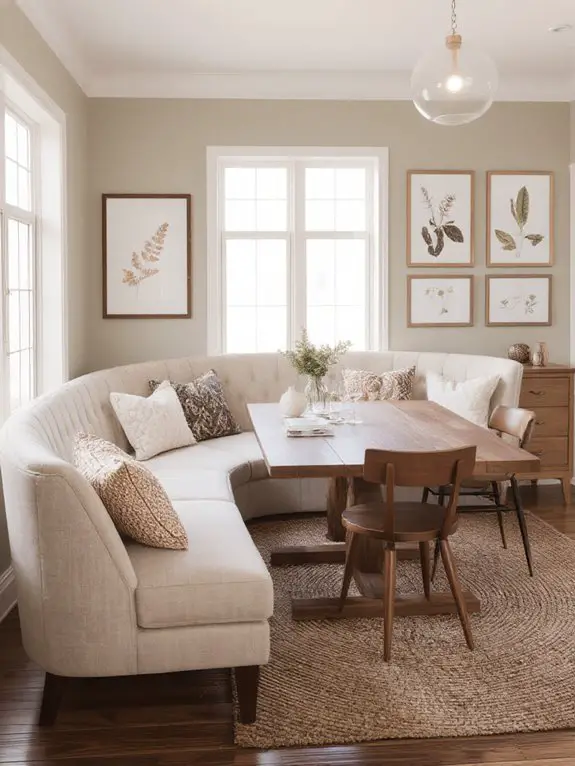
While traditional chairs can work well in a dining room, built-in banquettes offer a stylish and functional alternative that maximizes space and creates a cozy atmosphere. I’ve found that they’re perfect for smaller dining areas, as they tuck neatly against walls or corners, freeing up floor space.
Customizing the upholstery lets you match your decor, whether it’s sleek leather for a modern look or soft textiles for a warm feel. Plus, they’re great for family gatherings, offering comfortable seating for multiple people.
Adding storage underneath is a practical touch, perfect for stashing dining essentials or seasonal items.
Ceiling Medallions for Classic Detail
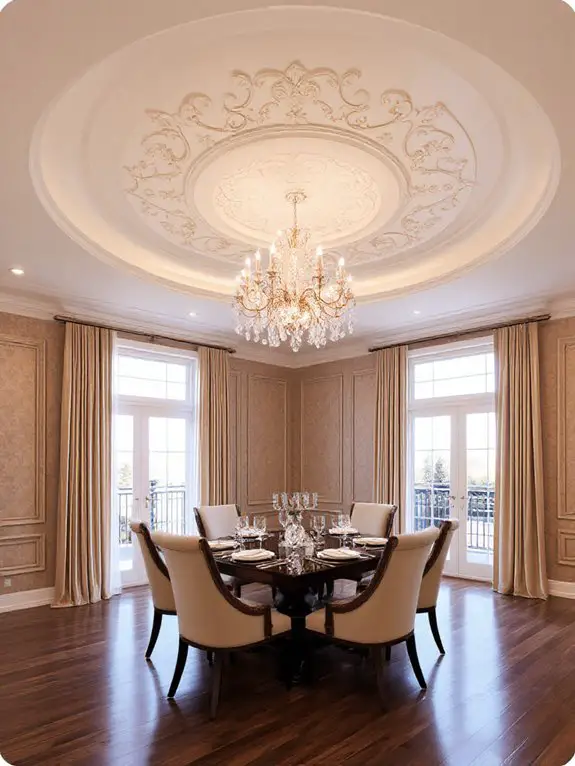
Though often overlooked, ceiling medallions can elevate a dining room’s elegance by adding architectural interest right where the eye naturally drifts upward. I’ve found they’re a simple yet impactful way to frame a chandelier or light fixture, drawing attention to the room’s focal point.
Opt for materials like plaster or polyurethane, which offer durability and intricate detailing. I recommend choosing a design that complements your dining room’s style, whether it’s ornate for a traditional look or minimalist for a modern vibe.
Installing one is straightforward—I’ve done it myself with adhesive and basic tools. It’s a small change that makes a big statement.
Hanging Pendant Lights for Ambiance
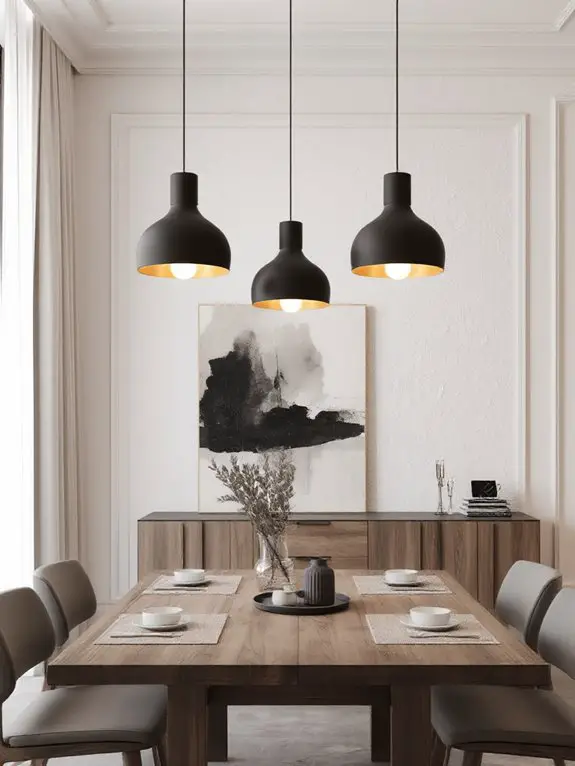
When I’m looking to create a warm and inviting atmosphere in a dining room, hanging pendant lights are one of my go-to solutions. They’re versatile, offering both functional illumination and a stylish focal point.
I prefer choosing fixtures that complement the room’s scale—large lights for spacious rooms, smaller ones for compact areas. The height matters too; positioning them 30-36 inches above the table guarantees ideal brightness without obstructing views.
I often opt for warm bulbs to enhance coziness. Materials like glass or metal add texture, while dimmable options let me adjust the mood for any occasion, from casual meals to formal gatherings.
Textured Wall Panels for Depth
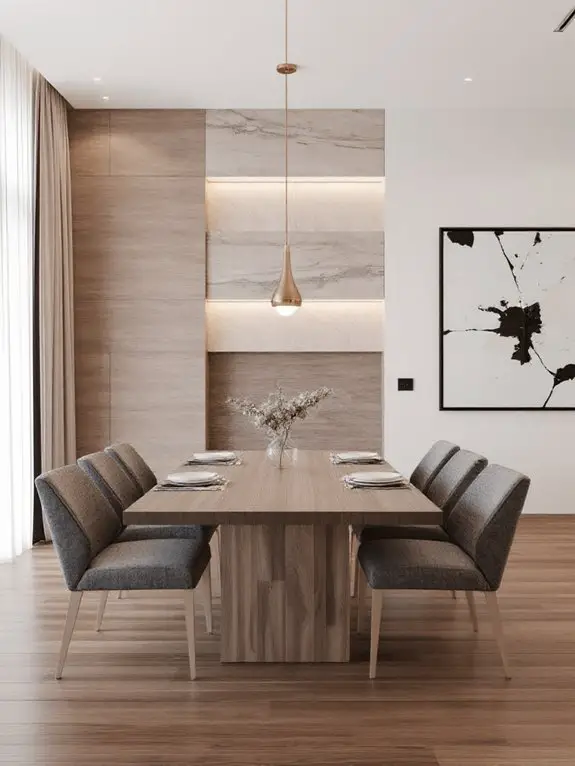
Textured wall panels can transform a dining room by adding visual interest and depth to an otherwise flat space. I often recommend incorporating materials like reclaimed wood, 3D geometric designs, or stone-like finishes to create a focal point.
These panels not only enhance the room’s aesthetics but also improve acoustics, making conversations more intimate during meals.
When installing, I suggest aligning them with the dining table or ceiling height for a cohesive look. Neutral tones keep the design timeless, though bold textures can make a statement too. They’re a practical way to elevate your dining experience without overwhelming the space.
Colorful Table Linens for Pop
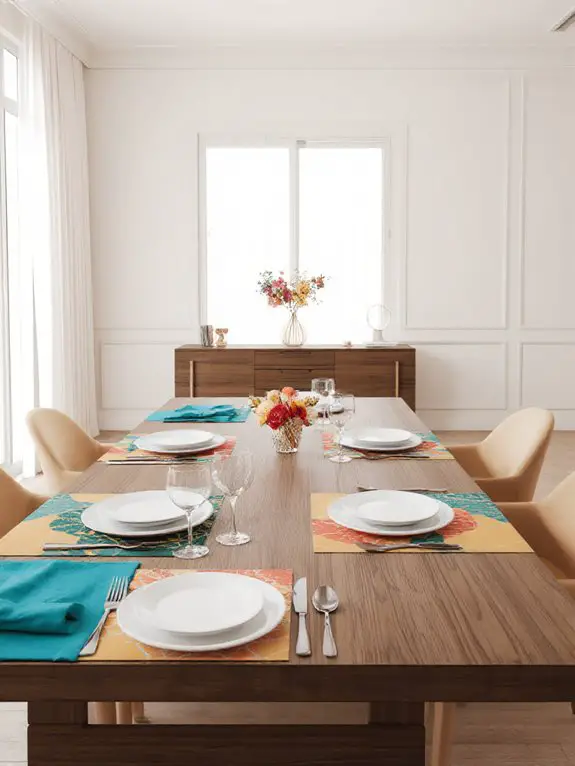
While neutral tones can create a calming atmosphere, colorful table linens are a simple yet effective way to inject energy and personality into your dining room. I often choose linens in bold hues like emerald green, deep turquoise, or vibrant coral to make a statement.
Mixing patterns, such as stripes with florals, adds visual interest without overwhelming the space. Opt for high-quality fabrics like cotton or linen for a polished look.
Don’t be afraid to change them seasonally—bright tones for summer, richer shades for fall. This small change can instantly transform the mood of your dining area.
Sculptural Centerpieces for Artistic Flair
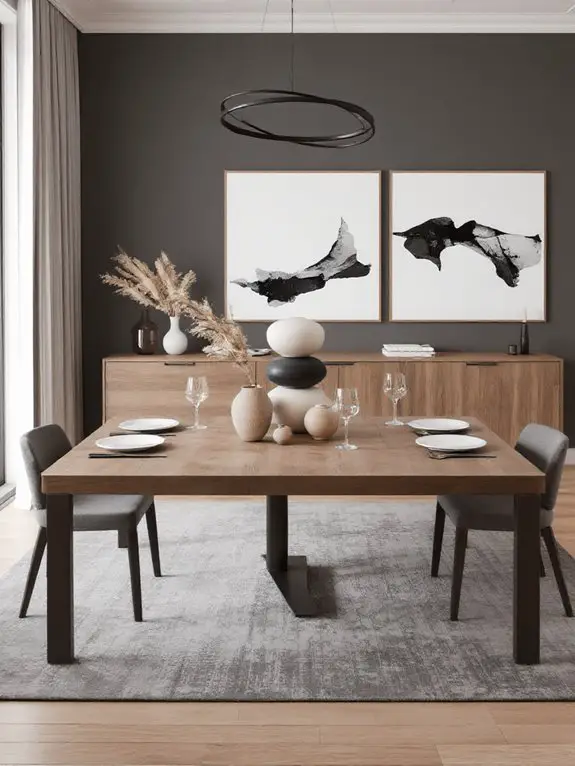
To elevate your dining room’s aesthetic, I recommend incorporating sculptural centerpieces that double as functional art. Choose pieces that reflect your personality while complementing the room’s overall design.
For modern spaces, opt for sleek, geometric sculptures in materials like metal or glass. In rustic settings, wooden or ceramic pieces with organic shapes work beautifully.
Don’t shy away from bold, oversized designs that command attention, but guarantee they don’t overwhelm the table’s proportions.
Consider pieces that serve a purpose, like candleholders or fruit bowls, blending artistry with utility. Sculptural centerpieces create a focal point, transforming meals into visually engaging experiences.
Multi-Functional Furniture for Small Spaces
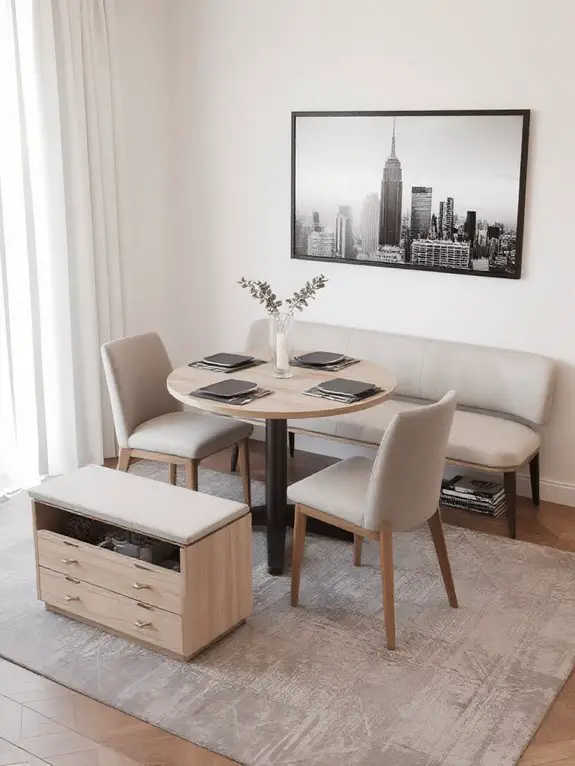
When space is limited, multi-functional furniture becomes an essential part of creating a dining room that’s both stylish and practical. I recommend opting for pieces like extendable tables that can shrink when not in use or expand to accommodate guests.
Consider benches with built-in storage for stashing linens or tableware, saving both space and clutter. Wall-mounted drop-leaf tables are another genius solution, folding away when you need floor space.
For added functionality, look for dining chairs that double as side tables or stack neatly when not in use. These clever designs maximize utility without compromising on style, making them perfect for small spaces.
Frequently Asked Questions
How to Incorporate Family Heirlooms Into Dining Decor?
I’ll incorporate family heirlooms by blending them seamlessly into my dining decor. I’ll display grandma’s china on open shelves, use great-grandpa’s clock as a centerpiece, and hang vintage photos to create a warm, personal space.
What Are the Best Materials for Dining Table Durability?
I’ve found that solid wood, like oak or walnut, offers unmatched durability for dining tables. Glass tops are scratch-resistant but prone to breakage, while metal bases provide sturdy support. Avoid particleboard—it doesn’t hold up well long-term.
Can I Mix Modern and Traditional Dining Room Styles?
Absolutely, I can mix modern and traditional dining room styles! It’s about balancing elements like pairing a sleek modern table with vintage chairs or adding traditional art to a minimalist space. It creates a unique, layered look.
How to Choose Dining Chairs for Ergonomic Comfort?
When choosing dining chairs for ergonomic comfort, I consider seat depth, height, and back support. I prefer chairs with padded seats and a slight curve in the backrest. Adjustable options or armrests can also improve long-term comfort.
What’S the Ideal Dining Room Layout for Large Gatherings?
I’d suggest an open layout with a large, round or oval table to encourage conversation. I’d leave enough space around the table for easy movement and consider adding a buffet or sideboard for extra serving space.

